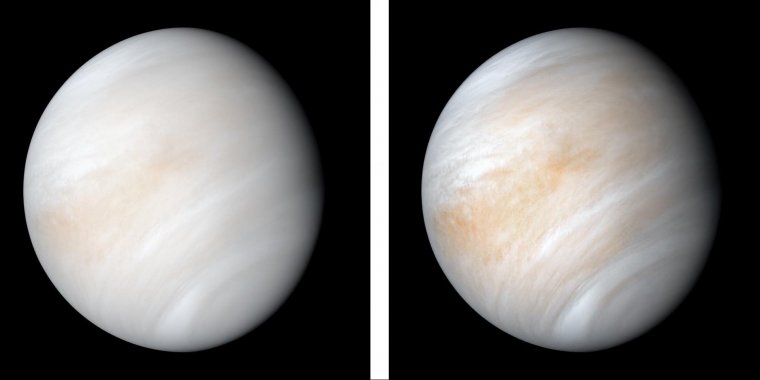| News / Science News |
Hints of life discovered on Venus
Astronomers have speculated for decades that high clouds on Venus could offer a home for microbes – floating free of the scorching surface, but tolerating very high acidity. The detection of phosphine molecules, which consist of hydrogen and phosphorus, is an important step in the search for life beyond Earth, a key question in science.

Venus. Photo: NASA/JPL-Caltech
The discovery was made by Professor Jane Greaves while she was a visitor at the University of Cambridge’s Institute of Astronomy. Greaves and her collaborators used the James Clerk Maxwell Telescope (JCMT) in Hawaii to detect the phosphine, and followed up their discovery on the Atacama Large Millimeter/submillimeter Array (ALMA) in Chile.
Both facilities observe Venus at a wavelength of about 1 millimetre, much longer than the human eye can see.
Luckily, conditions were good at ALMA for follow-up observations while Venus was at a suitable angle to Earth. Processing the data was challenging, however, as ALMA isn’t usually looking for subtle effects in bright objects like Venus.
“In the end, we found that both observatories had seen the same thing – faint absorption at the right wavelength to be phosphine gas, where the molecules are backlit by the warmer clouds below,” said Greaves.
Using existing models of the Venusian atmosphere to interpret the data, the researchers found that phosphine is present but scarce – only about twenty molecules in every billion.
The astronomers then ran calculations to see if the phosphine could come from natural processes on Venus. They caution that some information is lacking – in fact, the only other study of phosphorus on Venus came from one lander experiment, carried by the Soviet Vega 2 mission in 1985.
On Earth, phosphine is only made industrially or by microbes that thrive in oxygen-free environments. Co-author Dr William Bains from MIT led the work on assessing natural ways to make phosphine on Venus.
Ideas included sunlight, minerals blown upwards from the surface, volcanoes, or lightning, but none of these could make anywhere near enough. Natural sources were found to make at most one ten-thousandth of the amount of phosphine that the telescopes saw.
To create the observed quantity of phosphine on Venus, terrestrial organisms would only need to work at about 10% of their maximum productivity, according to calculations by co-author Dr Paul Rimmer of Cambridge’s Cavendish Laboratory. Any microbes on Venus will likely be very different from their Earth cousins though, to survive in hyper-acidic conditions.
“This discovery brings us right to the shores of the unknown,” said Rimmer. “Phosphine is very hard to make in the oxygen-rich, hydrogen-poor clouds of Venus and fairly easy to destroy. The presence of life is the only known explanation for the amount of phosphine inferred by observations.
“Both of these facts lie at the edge of our knowledge: the observations could be caused by an unknown molecule, or could be caused by chemistry we’re not aware of. Ultimately, the only way to find out what's really happening is to send a mission into the clouds of Venus to take a sample of the droplets and look at them to see what's inside.”
Earth bacteria can absorb phosphate minerals, add hydrogen, and ultimately expel phosphine gas. It costs them energy to do this, so why they do it is not clear. The phosphine could be just a waste product, but other scientists have suggested purposes like warding off rival bacteria.
Other possible biosignatures in the Solar System may exist, like methane on Mars and water venting from the icy moons Europa and Enceladus. On Venus, it has been suggested that dark streaks where ultraviolet light is absorbed could come from colonies of microbes.
The Akatsuki spacecraft, launched by the Japanese space agency JAXA, is currently mapping these dark streaks to understand more about this unknown ultraviolet absorber.
Although the high clouds of Venus have temperatures up to a pleasant 30 degrees Celsius, they are incredibly acidic – around 90% sulphuric acid – posing major issues for microbes to survive there. The researchers are investigating the possibility that the microbes could shield themselves inside droplets. (University of Cambridge)
YOU MAY ALSO LIKE





